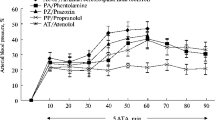Abstract
The effects of graded doses of compound 48/80 on various cardiovascular and respiratory parameters were studied in pentobarbitone-anaesthetized rats. Following intravenous injections, this compound significantly depressed the mean blood pressure (MBP), left ventricular pressure (LVP) and dLVP/dtmax, and caused ventricular tachycardia (VT) or fibrillation (VF) and death. Heart rate (HR) response were variable, and there were no marked changes in airway resistance or blood gases. Pretreatment of the animals with either cimetidine or diphenhydramine significantly prolonged the time of onset of VT/VF but failed to alter the changes in other circulatory variables. A combination of cimetidine and diphenhydramine significantly alleviated the decreases in MBP and LVP and prevented the occurrence of VT/VF. It is suggested that the circulatory depression and the occurrence of ventricular arrhythmias following the administration of compound 48/80 result from activation of H1- and H2-receptors by elevated blood histamine levels due to release of the amine from tissues.
Similar content being viewed by others
References
J. P. Trzeciakowski and R. Levi,Reduction of ventricular fibrillation threshold by histamine: resolution into separate H 1-and H 2-mediated components. J. Pharmacol. Exp. Ther.223, 774–783 (1982).
R. Levi, D. A. A. Owen and J. Trzeciakowski,Actions of histamine on the heart and vasculature. InPharmacology of histamine receptors. (Eds. C. R. Ganellin and M. E. Parsons) pp. 236–297. Wright PSG, London 1982.
R. W. Gristwood, D. A. A. Owen, P. Romanec and K. A. Sampford,Histamine and myocardial dysfunction. InFrontiers in histamine research. (Eds. C. R. Ganellin and J. C. Schwartz) pp. 309–315. Pergamon Press, Oxford 1985.
S. Dai,Effects of ranitidine and cimetidine on experimentally induced ventricular arrhythmias in anaesthetized rats. Agents and Actions17, 460–465 (1986).
S. Dai,Ventricular histamine concentrations and arrhythmias during acute myocardial ischaemia in rats. Agents and Actions21, 66–71 (1987).
S. Dai and C. W. Ogle,Ventricular histamine concentrations and mast cell counts in the rat heart during acute ischaemia. Agents and Actions29, 138–143 (1990).
S. Dai,Histamine enhances hypoxia-induced ventricular arrhythmias in isolated rat hearts. Clin. Exp. Pharmacol. Physiol.16, 925–931 (1989).
F. L. Pearce, H. Ali, K. E. Barrett, A. D. Befus, J. Bienenstock, J. Brostoff, M. Ennis, K. C. Flint, N. McI. Johnson, K. B. P. Leung and P. T. Peachell,Mast cell heterogeneity differential responsitivity to histamine liberators and anti-allergic drugs. InFrontiers in histamine research. (Eds. C. R. Ganellin and J. C. Schwartz) pp. 411–421. Pergamon Press, Oxford 1985.
T. I. Florjanc and F. Erjavec,Alterations in histamine levels in the rat induced by compound 48/80. Agents and Actions20, 194–197 (1987).
F. L. Pearce,Mast cell heterogeneity. Trends Pharmacol. Sci.44, 165–167 (1983).
D. M. Philbin, J. Moss, C. E. Rosow, C. W. Akins and J. L. Rosenberger,Histamine release with intravenous narcotics: Protective effects of H 1-and H 2-receptor antagonists. Klin. Wochenschr.60, 1056–1059 (1982).
W. Lorenz and A. Doenicke,H 1 and H 2 blockade: A prophylactic principle in anesthesia and surgery against histamine-release responses of any degree of severity: Part I New Engl. Reg. Allergy Proc.6, 37–57 (1985).
E. Inada, D. M. Philbin, V. Machaj, J. Moss, M. N. D'Ambra, C. E. Rosow and C. W. Akins,Histamine antagonists and d-tubocurarine-induced hypotension in cardiac surgical patients. Clin. Pharmac. Ther.40, 575–580 (1986).
M. Tryba, F. Zevounou and M. Zenz,Prevention of histamine-induced cardiovascular reactions during the induction of anaesthesia following premedication with H 1-+H 2-antagonists I. M. Br. J. Anaesth.58, 478–482 (1986).
W. Lorenz and A. Doenicke,H 1 and H 2 blockade: A prophylactic principle in anaesthesia and surgery against histamine-release responses of any degree of severity: Part II. New Engl. Allergy Proc.6, 174–193 (1985).
R. W. Brimblecombe, D. A. A. Owen and M. E. Parsons,The cardiovascular effects of histamine in laboratory animals. Agents and Actions4, 191–192 (1974).
C. A. Papacostas, E. R. Loew and G. B. West,Studies on the toxicology of a histamine liberator, compound 48/80. Arch. Int. Pharmacodyn.120, 353–362 (1959).
E. Angaard and K. Strandberg,Efflux of prostaglandin E 2 from cat paws perfused with compound 48/80. Acta Physicol. Scand.,82, 333–344 (1971).
K. Strandberg and B. Uvnas,Purification and properties of the slow reacting substance formed in the cat paw perfused with compound 48/80. Acta Physiol. Scand.82, 358–374 (1971).
S. Dai,A study of the actions of histamine on the isolated rat heart. Clin. Exp. Pharmacol. Physiol.3, 359–367 (1976).
A. J. Lewis and P. Eyre,Some cardiorespiratory effects of histamine, 5-hydroxytryptamine, and compound 48/80 in the calf. Can. J. Physiol. Pharmacol.50, 545–553 (1972).
R. Levi, M. A. Beaven, R. D. Luskind, C.-H. Lee, J. Trzeciakowski and W. A. Gay Jr.,Release of cardiac histamine by chemicals and drugs: Effects and complications. Fed. Proc.39, A642 (1980).
H. Ali and F. L. Pearce,Isolation and properties of cardiac and other mast cells from the rat and guinea-pig. Agents and Actions16, 138–140 (1985).
P. F. Mannaioni,Physiology and pharmacology of cardiac histamine, revisited. InFrontiers in histamine research. (Eds. C. R. Ganellin and J. C. Schwartz) pp. 301–304. Pergamon Press, Oxford 1985.
P. Eyre and N. Chand,Histamine receptor mechanisms of the lung. InPharmacology of histamine receptors. (Eds. C. R. Ganellin and M. E. Parsons) pp. 298–322. Wright PSG, London 1982.
H. Y. A. Lau and F. L. Pearce,Dual effect of antihistamines on rat peritoneal mast cells: induction and inhibition of histamine release. Agents and Actions16, 176–178 (1985).
H. Y. A. Lau and F. L. Pearce,Effects of antihistamines on isolated mast cells from the rat, guinea pig and man. Agents and Actions18, 107–109 (1986).
Author information
Authors and Affiliations
Rights and permissions
About this article
Cite this article
Dai, S. Circulatory depression and ventricular arrhythmias induced by compound 48/80 in anaesthetized rats. Agents and Actions 34, 316–323 (1991). https://doi.org/10.1007/BF01988722
Received:
Accepted:
Issue Date:
DOI: https://doi.org/10.1007/BF01988722



